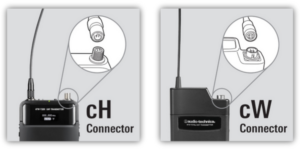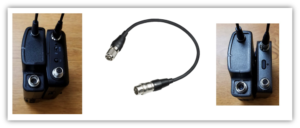Question: What distinguishes the new cH-style wireless connector from the cW-style connector?
Answer: Audio-Technica professional wireless body-pack transmitters have traditionally utilized a cW-style 4-pin locking connector. This connector can be found on body-pack transmitters for our System 10, 2000 Series, and previous generations of the 3000 Series and 5000 Series. The BP892cW subminiature headworn microphone is an example of a microphone terminated with the cW-style connector that is commonly used with the above-mentioned wireless systems. (A few years back, in a previous Question of the Week, we discussed the differences between the connectors that existed at the time.) But with the release of the new generations of Audio-Technica wireless systems, a sleeker, more robust connector has been developed for body-pack transmitters – a change that users should find beneficial.

The wireless connector used with the 3000 Series (4th Generation), 5000 Series (3rd Generation), 6000 Series, and future systems is identified as a cH-style screw-down 4-pin connector. The new cH-style connector is notably smaller than the cW-style connector, allowing the body-pack transmitter itself to be smaller, as shown in the images below. Whether you use a microphone or cable, this new rugged, threaded cH-style screw-down connector gives you a strong, secure connection, plus the advantage of a smaller, less cumbersome unit.

Popular Audio-Technica wireless microphones are available with the cH-style connector, including the BP892cH and the AT899cH. If you have a legacy Audio-Technica wireless microphone with the cW-style connector, you can use the AT-cWcH Adapter Cable to fit your existing microphone to the new cH-style screw-down connector. If you have further questions about the cH-style connector, feel free to contact the Audio Solutions Department.